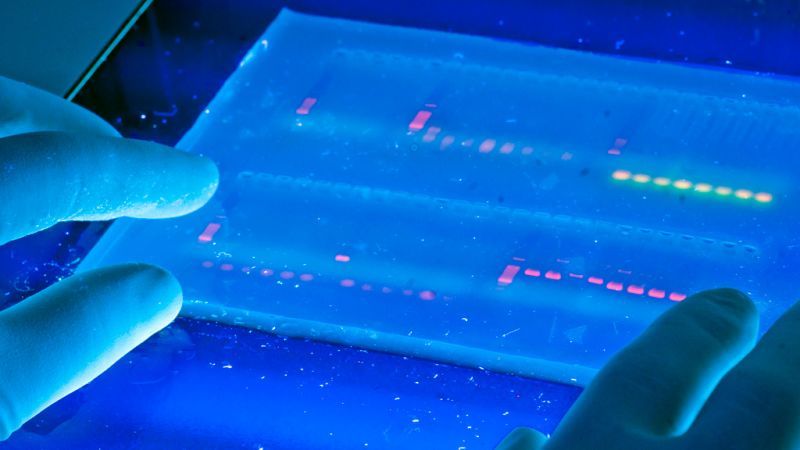Anheuser-Busch says it reserved 40 electric big rigs.




It worked. Working with mice, they were able to reverse the disease symptoms of kidney disease, type 1 diabetes, and a form of muscular dystrophy. In the mouse with kidney disease, for example, they turned on two genes associated with kidney function and saw the kidney function improved.
The unassumingly named CRISPR/Cas9 is a technology that stands to remake the world as we know it. By allowing scientists to more easily than ever cut and paste all those As, Cs, Ts, and Gs that encode all the world’s living things, for one thing, it could one day cure many devastating diseases.
All that power, though, comes with one pretty sizable caveat: Sometimes CRISPR doesn’t work quite like we expect it to. While the scientific establishment is still embroiled in a debate over just how serious the problem is, CRISPR sometimes causes off-target effects. And for scientists doing gene editing on human patients, those mutations could wind up inadvertently causing problems like tumors or genetic disease. Yikes.


The robots are coming for your … chess game.
Google’s AI, AlphaZero, developed a “superhuman performance” in chess in just four hours.
Essentially, the AI absorbed humanity’s entire history of chess in one-sixth of a day — and then figured out how to beat anyone or anything.
After being programmed with the rules of the game (not the strategy) AlphaZero played 100 games against Stockfish, the world champion chess program. AlphaZero won 25 playing as white (which has first-mover advantage) and three games playing as black. The last 72 games were a draw with AlphaZero recording no losses and Stockfish recording no wins.


Awesome!
A few months after demonstrating its dominance over the game of Go, DeepMind’s AlphaZero AI has trounced the world’s top-ranked chess engine—and it did so without any prior knowledge of the game and after just four hours of self-training.
AlphaZero is now the most dominant chess playing entity on the planet. In a one-on-one tournament against Stockfish 8, the reigning computer chess champion, the DeepMind-built system didn’t lose a single game, winning or drawing all of the 100 matches played.

At the end of October, I delivered a keynote speech at the Cryptocurrency Expo in Dubai. That was just 5 weeks ago. When I left for the conference, Bitcoin was trading at $6,300/BTC. But in the next few weeks, it reached $10,000. Last week, I liquidated part of my investment at just under $13,000/BTC. Now, Bitcoin is about to cross $16,000. (I began writing this 10 minutes ago…but it has risen another $1600.00. Now, it is $17,000).
Dear Reader: I believe in Bitcoin. Yet, there is a “But” in the last paragraph below…
I believe in Bitcoin. Its rise is not fueled solely by investor hysteria. Rather, it is a product of delayed appreciation for a radical, transformative network technology.
In the mid 1970s, the microprocessor was spreading to every consumer gadget. It started a trend toward tools that added power and enjoyment to all facets of life. And they were quickly becoming faster, lower-power, lower-cost and more ubiquitous. If you understood the potential of the computer chip before mainstream investors, you couldn’t really invest directly in the microprocessor. After all, it is a platform improvement. But you could come very close—You might have invested in Intel, Fairchild or Texas Instruments.
Jump forward 20 years: In the mid 1990s, the Internet was spreading to every class of citizen and to all corners of the earth. But just as with a computer chip, you could own a web site, but you couldn’t own a piece of the internet’s market potential. You can’t invest in an idea, unless you are the inventor and you hold a patent.
But, 5, 6 and 7 years ago, many individuals saw the future. They understood that Bitcoin is transformative. They recognized that—contrary to popular misconception—Bitcoin is backed by something more tangible than dollars, Euros and Renminbi. More importantly, it exhibits the potential to become the global reserve currency. And it continues to do so, even as internal bickering threatens its utility as a consumer payment instrument. That’s because It diverts liquidity away from gold and national FIAT. Ultimately, it forces governments to be transparent and accountable to its citizens. This is further reinforced by rampant inflation in countries around the world and a growing list of trading partners who seek alternatives to the US dollar.

But, just like real estate, the supply of Bitcoin is capped. No one can produce more. It’s the math, stupid! Even if you only realized this one year ago, you still would have reaped a 2000% return on your investment as of this morning. (I am cherry-picking here, but Bitcoin had just crossed $630 on October 20 2016).
Let’s be clear: This is not a dot-com bubble or a 17th century Dutch tulip bulb mania. It is far more comparable to the 19th century California gold rush. The only frenzy is to acquire a functional instrument that is still trading for far below par value—but with the strange caveat that hoarding retards liquidity and the ‘functional’ adoption that we need to sustain long-term value.
The Bottom Line
In the grand scheme of things, Bitcoin is still undervalued—even at $17,000/BTC. It will fall and it will rise, but it will certainly be valued higher years from now.
…But, I must admit that this sudden and urgent race into outer space is a bit unsettling. From an investor perspective, it is not rational to leave when I recognize that the exuberance is rational. Yet, here we are at $17,000. I am taking some bitcoin off the table—A bit of bitcoin.
Philip Raymond co-chairs CRYPSA, publishes Wild Duck and hosts the New York Bitcoin Event. He is on the New Money Systems board and led the Cryptocurrency Expo in Dubai. He frequently consults and presents.

Mukherjee is now 47 and lives in New York; Marsh, 67, lives in Oxford. To different extents both of these doctors still practise in their respective fields – Mukherjee at Columbia University’s cancer centre, Marsh as a visiting doctor at various hospitals around the world, including in Kathmandu in Nepal. Both men have continued to write: Marsh a second volume of autobiography, called Admissions, published this year, and Mukherjee a study of genetics called The Gene: An Intimate History, published last year. When they sat down to talk to each other over Skype one Saturday afternoon in November, they began with a subject on which their two lifelong disciplines overlap: the treatment of brain cancer.
The cancer specialist and the neurosurgeon talk about treating cancer, writing and facing death in their own families by Tom Lamont.
There are a lot of people in the world that need glasses on a daily basis. Despite their often expensive price tag, they do little more than correct poor eyesight. Let Glass updates glasses for the 21st century by integrating them with smart home connectivity.
While maintaining a slim form factor, Let Glass features audio entertainment, telephone communication, and voice interaction. Using Alexa and a built-in microphone, these frames allow users to control their smartphones without fumbling through their pockets. Simply tapping the legs of the smart glasses activate remote control functions, while voice commands handle everything else. In addition to Amazon Alexa, Apple Siri and Google Now are also supported.
Keeping with a traditional appearance, audio is produced using bone conduction technology. Instead of a speaker, the glasses vibrate the small bones in the ear to produce sound. This also keeps ears open to other noises, ensuring users remain aware of their surroundings. This allows users to listen to music, track activity, use voice navigation, call a friend, and more.